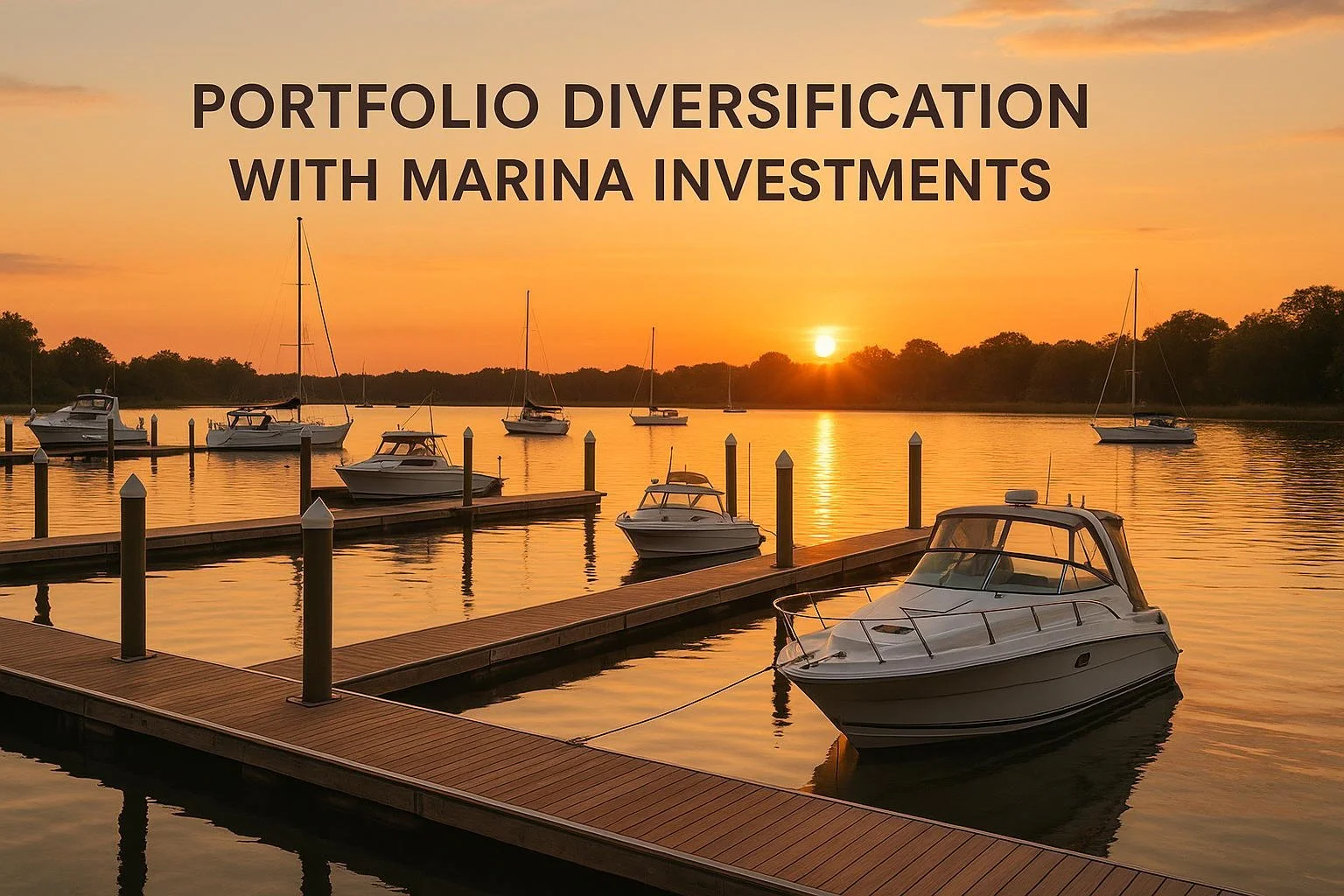Portfolio Diversification with Marina Investments
Marina investments are a rising opportunity in real estate, offering steady income, tax benefits, and resilience against market shifts. These properties combine real estate ownership with revenue from services like boat slip rentals and maintenance, making them a strong option for balancing risk in your portfolio. Here’s why marinas stand out and how to get started:
- Income Stability: Long-term leases for boat slips ensure regular cash flow, even during economic downturns.
- Limited Supply: Waterfront properties are scarce, reducing competition and increasing value over time.
- Tax Advantages: Marinas qualify for 1031 exchanges and provide depreciation benefits.
- Financing Options: Choices include SBA 504 loans, private equity, and syndication deals, each with unique trade-offs.
- Risk Management: Address potential challenges like weather risks and seasonal income with insurance and experienced operators.
Marinas cater to affluent clientele, making them a reliable addition to any real estate portfolio. Tools like CoreCast can further simplify market analysis, deal tracking, and stakeholder reporting. Ready to explore this niche? Keep reading for actionable steps on market research, due diligence, and financing strategies.
How Marinas Add Value to Portfolio Diversification
Main Benefits of Marina Investments
Marinas bring a unique edge to portfolio diversification by offering consistent cash flows, tax advantages, and a degree of economic resilience. Boat slip rentals typically operate on annual or seasonal leases, ensuring a steady stream of revenue and minimizing vacancy risks. These long-term leases provide stability, as boat owners often view their slips as necessities, making them more likely to renew even during periods of economic uncertainty. Additionally, marina operators often require deposits or advance payments, which further supports cash flow management.
From a tax perspective, marinas qualify for 1031 exchanges and provide depreciation benefits on infrastructure, offering significant tax-saving opportunities.
Marinas have also demonstrated resilience across different economic cycles. While spending on luxury items may dip during downturns, boat owners with existing slip leases often maintain their commitments. This reliability, paired with the scarcity of waterfront property, boosts pricing power and reduces competition over time - key factors that strengthen the appeal of marina investments.
Marinas vs. Other Specialty Asset Classes
Marinas stand out among specialty real estate investments, offering a rare combination of stable income and long-term growth potential. Unlike other asset classes that might focus solely on higher yields or simpler operations, marinas benefit from the scarcity premium tied to waterfront locations. This unique positioning can lead to both consistent revenue and capital appreciation over time.
When compared to other specialty assets like self-storage facilities or RV parks, marinas present distinct operational challenges and opportunities. For instance, while some assets might deliver higher returns with less complexity, marinas demand specialized management due to factors like environmental regulations and seasonal patterns. These characteristics make marinas a complementary addition to a diversified real estate portfolio, blending defensive income with the potential for growth.
Taken together, these benefits highlight why marinas are a strategic option for investors looking to diversify their real estate holdings effectively.
E10: Marina Investing with South Silver Group

Steps to Add Marina Acquisitions to Your Portfolio
If you're considering adding marinas to your investment portfolio, here’s a straightforward guide to help you navigate the process.
Research Marina Markets
Understanding the local marina market is the first step to making informed investment decisions. Start by analyzing factors that drive demand, such as boating activity and regional growth trends. Look for areas with established boating communities or places where interest in recreational boating is on the rise. Pay attention to local conditions that may limit new waterfront developments - these constraints can help maintain a favorable balance between supply and demand.
Demographic trends like population growth, job creation, and increasing property values also play a role in determining market potential. Additionally, take into account seasonal variations, as these can impact both operational timelines and cash flow in different regions.
Once you’ve identified promising markets, move on to conducting detailed due diligence to ensure your investment is sound.
Complete Due Diligence
Marina investments come with unique risks, so due diligence is critical. Start with an environmental assessment to address potential issues like spills or water quality concerns. Review lease agreements and other contracts to understand revenue stability and any operational obligations tied to the property.
It’s also important to verify existing permits and stay informed about regulatory changes that might lead to future expenses. Lastly, inspect the physical condition of docks, utilities, and other facilities to identify maintenance needs that could impact the asset’s long-term performance.
Determine Portfolio Allocation to Marinas
After assessing market dynamics and risks, decide how marinas fit into your broader investment strategy. Consider your risk tolerance, investment horizon, and available capital when determining the allocation. Diversifying geographically and across different asset types can help balance risks and ensure stability.
Adding marina investments to your portfolio can provide resilience by offsetting the economic cycles and market behaviors of other property types.
Manage Marina Investment Risks
Marina investments come with specific challenges, including risks from climate change and extreme weather. Rising sea levels and severe storms can damage infrastructure, so securing robust insurance coverage is essential. Coverage should address risks like flooding, wind damage, and potential business interruptions.
To manage operations effectively, collaborate with experienced marina operators who can handle maintenance, regulatory compliance, and the complexities of seasonal staffing. Additionally, mitigate risks like market concentration and liquidity issues by diversifying your investments across regions and maintaining financial reserves for unexpected expenses.
sbb-itb-99d029f
Financing Options for Marina Acquisitions
Investing in marinas requires a tailored approach to financing due to the unique nature of these properties. Selecting the right funding strategy is essential for navigating the complexities of marina acquisitions.
Common Financing Methods
Conventional Commercial Loans
This is one of the most widely used options for financing marina purchases. These loans typically require a large down payment and offer long-term repayment terms. However, lenders often scrutinize marina properties closely, favoring those with steady cash flow and experienced operators.
SBA 504 Loans
If part of the marina property is used for your business, SBA 504 loans can be a good fit. These loans offer lower down payments and fixed interest rates on the SBA-backed portion. However, they do come with a requirement: a portion of the property must be owner-occupied.
Private Equity Partnerships
For larger acquisitions, private equity partnerships can provide not just the capital but also valuable operational expertise. That said, this option often involves shared decision-making and profit sharing, which may not suit every investor.
Syndication Deals
Syndication deals allow multiple investors to pool their resources to acquire high-value marina properties. This approach spreads out the risk while enabling access to premium opportunities, though it also involves shared profits and complex arrangements.
1031 Exchanges
This tax strategy allows you to defer capital gains taxes when reinvesting proceeds from one qualifying property into another. It’s a smart way to diversify your real estate portfolio by adding marina assets while minimizing tax liabilities.
These varied financing methods offer flexibility, but each comes with its own set of trade-offs.
Working with Marina Lenders
Once you’ve chosen a financing method, it’s critical to work with lenders who understand the nuances of marina investments. Unlike other commercial properties, marinas come with unique challenges like seasonal income fluctuations and weather-related risks. Local community banks or regional lenders often have a better grasp of these factors compared to larger financial institutions.
Lenders in this niche typically require higher debt service coverage ratios to account for unpredictable income streams. They also place significant weight on the marina’s historical financial performance.
Appraising marina properties can be tricky. Specialized appraisers are often needed, which may extend the timeline for closing. The valuation process usually relies heavily on the income approach, but seasonal adjustments and variable expenses can complicate the analysis.
Environmental assessments are another key component of due diligence. At a minimum, lenders will require a Phase I environmental study, and a Phase II assessment may be necessary in certain cases, even if no contamination is immediately evident. These assessments can increase the overall cost of due diligence.
Loan-to-value ratios for marinas are generally more conservative compared to other commercial real estate types. This reflects concerns about the niche market and the operational complexities of marina properties.
Financing Structure Comparison
| Financing Method | Typical Down Payment | Interest / Returns | Term Length | Key Advantages | Main Drawbacks |
|---|---|---|---|---|---|
| Conventional Commercial Loans | Substantial | Competitive | Long-term | Simple process; widely available | High qualification standards |
| SBA 504 Loans | Lower | Fixed rate on SBA portion | Extended | Lower upfront costs; attractive terms | Requires partial owner-occupancy |
| Private Equity Partnerships | Varies | Performance targets | Short- to mid-term | Access to large deals and expertise | Shared profits; reduced control |
| Syndication Deals | Varies | Competitive | Flexible | Shared risk; access to premium properties | Complex structuring; shared profits |
| Seller Financing | Moderate | Negotiable | Variable | Flexible terms; quicker closing process | Limited availability; potential balloon payments |
Bridge Financing
For investors needing quick access to funds, bridge financing from hard money lenders offers a fast-track solution. These loans typically come with higher interest rates and shorter refinancing periods but can be a lifesaver for time-sensitive deals.
Portfolio Lenders
Some lenders keep loans on their books instead of selling them, offering more flexibility in underwriting. This approach often considers unique property features and local market dynamics. Building strong relationships with portfolio lenders can provide long-term advantages.
The marina financing market is evolving, with credit unions and specialty lenders increasingly stepping in. These institutions often provide more personalized service and faster decisions, though their loan sizes may be limited.
Using CoreCast for Marina Portfolio Management

Managing marina investments comes with its own set of challenges, from seasonal fluctuations to the unique demands of waterfront properties. CoreCast, an all-in-one real estate intelligence platform, provides tools for tracking, analyzing performance, and making informed decisions across your marina portfolio.
Access Real-Time Marina Market Data
Marina markets can change rapidly due to factors like seasonal demand, weather, and local economic conditions. CoreCast’s integrated mapping and historical data features allow you to visualize properties and market trends in real time. This geographic view helps pinpoint market gaps and uncover opportunities in areas that may be underserved.
By reviewing historical trends, you can compare potential acquisitions with your current portfolio, ensuring every decision is backed by data. The platform’s analytics are designed to handle both standard real estate metrics and those unique to waterfront properties.
Track Deals and Report to Stakeholders
Marina acquisitions often involve intricate deal structures and multiple parties. CoreCast’s pipeline tracker keeps deals organized, from initial research to final closing. Its stakeholder center generates customized, branded reports, helping you maintain transparency and keep all parties informed. You can also tailor deal stages to fit the specific needs of marina investments.
Sharing detailed performance metrics with investors builds trust and ensures everyone stays aligned throughout the investment process.
Simplify Due Diligence and Portfolio Analysis
Due diligence for marinas requires careful attention to their unique revenue patterns and operational demands. CoreCast’s portfolio analysis tools integrate seasonal cash flows from marinas with your broader holdings, giving you a clear picture of how these assets fit into your overall strategy.
The platform’s underwriting tools work across all asset types and risk profiles, allowing you to evaluate marina deals using consistent financial models. You can factor in marina-specific revenue streams, then compare these investments to your risk and return goals.
CoreCast also connects with third-party data sources to streamline due diligence. This integration helps evaluate operational efficiency and identify areas for improvement. On top of that, its transaction management tools simplify the often-complicated closing process by tracking every milestone in one central location. This organized approach ensures nothing falls through the cracks, leading to smoother transactions and better long-term portfolio management for your marina investments.
Getting Started with Marina Investments
Marina investments present a chance to diversify your portfolio, tapping into a market that’s poised for growth. The global marina market is projected to double in size over the next decade[1], and in 2023 alone, the U.S. marina industry generated $6.7 billion in revenue[2]. These waterfront assets are particularly appealing due to their limited supply and high barriers to entry, which help safeguard their long-term value.
Key Insights About Marinas
Marinas generate income through multiple streams, including berth rentals, maintenance services, fuel sales, and retail operations. This diversified revenue model supports resilient cash flows, with EBITDA margins typically ranging from 20% to 40%[1].
For financing, programs like SBA and USDA loans can guarantee up to 90% of the amount, with repayment terms stretching as long as 40 years. In high-demand coastal areas, commercial mortgage rates remain competitive, making financing an attractive option for investors[3][4].
Technology plays a crucial role in managing marina portfolios efficiently. Platforms like CoreCast simplify operations by offering real-time market data, integrated mapping, and underwriting tools tailored to the unique challenges of waterfront properties. Features like pipeline tracking and stakeholder reporting are particularly useful when navigating the often-complex deal structures involved in marina acquisitions.
Market fundamentals further strengthen the case for marina investments. With over 25 million motor and sailing yachts worldwide - and that number steadily increasing - demand continues to outpace supply[1]. In Europe, for instance, more than 80% of marinas operate at near full capacity during peak seasons, with premium locations like the Balearic Islands seeing waiting lists that can stretch over two years[1].
Planning Your Next Move
To make the most of marina investments, focus on markets with strong recreational boating activity and limited competition. Coastal areas with high occupancy rates and promising revenue growth are particularly attractive. Look for marinas that offer additional amenities like boat rentals, repair services, and waterfront dining, as these features can enhance profitability. Properties that incorporate technology and sustainability measures are also favored by lenders, as these improvements are seen as indicators of long-term success[4].
Use your research and due diligence to identify promising opportunities. Tools like CoreCast can streamline your market analysis, deal tracking, and communication with stakeholders, giving you a comprehensive view of your investments.
The marina sector remains highly fragmented on a global scale, offering significant opportunities for consolidation and value-driven upgrades[1]. By combining strategic financing, careful due diligence, and effective management tools, you can take advantage of this growing asset class while enjoying the diversification benefits it brings to your portfolio.
FAQs
What should I look for when choosing a marina market to invest in?
When you're eyeing a marina market for investment, the location should be your first priority. Being close to active boating communities or areas with strong demand can make a big difference in profitability.
You'll also want to dig into the market demand - this means looking at factors like regional boating activity, local economic conditions, and boat ownership trends. These elements can give you a clear picture of the market's strength.
Don't forget to evaluate the financial performance of marinas in the region. Check out their occupancy rates and revenue sources to get a sense of what kind of returns you might expect. Markets with untapped growth potential or a limited supply of marinas could present rare opportunities for long-term gains.
How do marinas compare to other niche real estate investments in terms of risk and return?
Marinas offer a balanced risk profile combined with strong returns, making them an appealing option for diversifying real estate investments. In 2023, the marina industry generated $6.7 billion in revenue, supported by high occupancy rates and solid profit margins. This reflects a steady potential for consistent cash flow.
While marinas share some of the same risks as other commercial real estate - like market shifts and operational challenges - their fundamentals remain solid. Compared to more traditional investments like bonds, marinas often deliver higher yields. However, they do require hands-on management to address both operational and market-related complexities effectively.
For investors looking to strike the right balance between risk and reward, marinas provide a unique chance to enter a growing and resilient sector while broadening their investment portfolios.
What financing options are available for buying marina properties, and what are their pros and cons?
Financing a marina property in the U.S. often involves options like traditional bank loans, SBA loans, or specialized marina loans. Loan amounts can range widely, from $100,000 to over $15 million, with loan-to-value ratios typically falling between 55% and 80%. Terms usually span 3 to 10 years. SBA loans, in particular, stand out for their competitive interest rates, which are generally 1.75%–2.75% above the prime rate, making them a popular choice for many investors.
These financing options come with clear benefits, such as access to substantial funding and the possibility of lower interest rates, especially with SBA loans. However, they also have their challenges. Lenders may require high credit scores and detailed financial documentation, which can make qualifying more difficult. Additionally, because the marina market is quite niche, finding loans specifically tailored to marina properties can be more challenging.
For those aiming to simplify their decision-making, tools like CoreCast offer real-time insights and portfolio analysis. These tools can help investors evaluate financing options and estimate potential returns on their marina investments.

